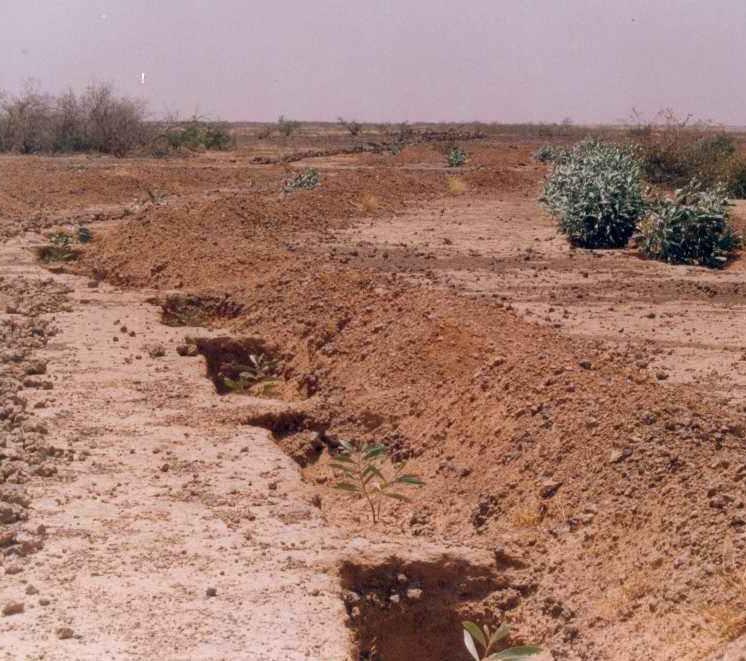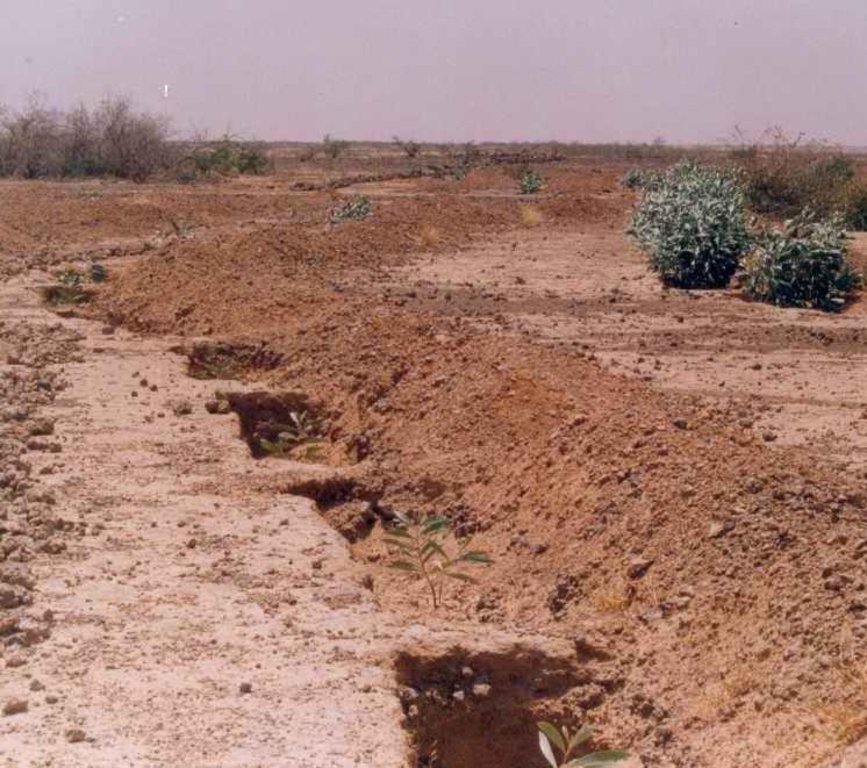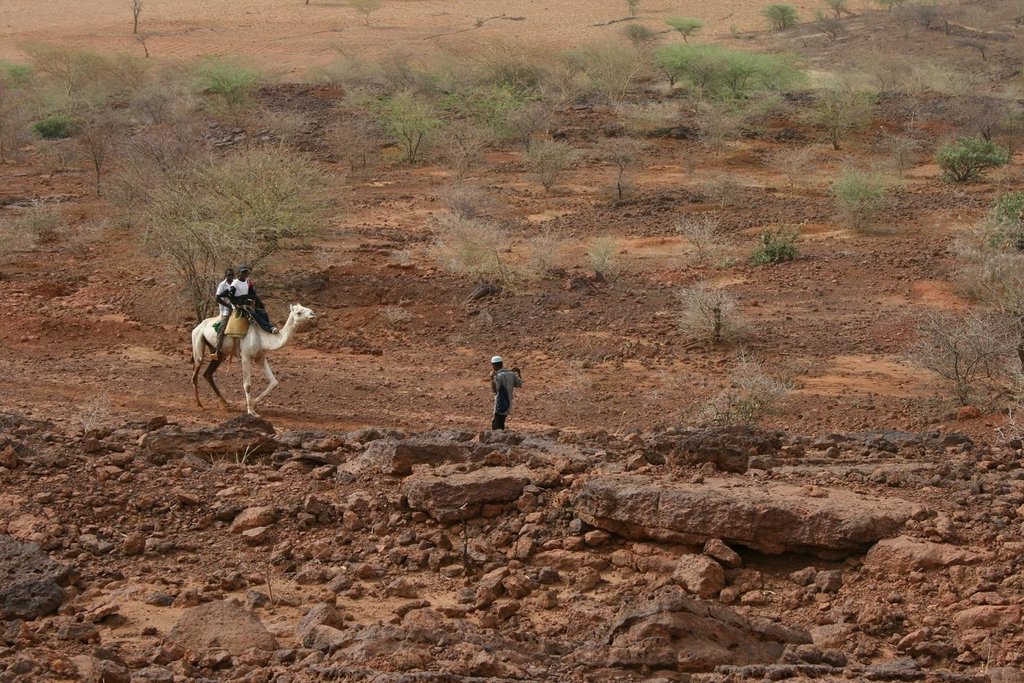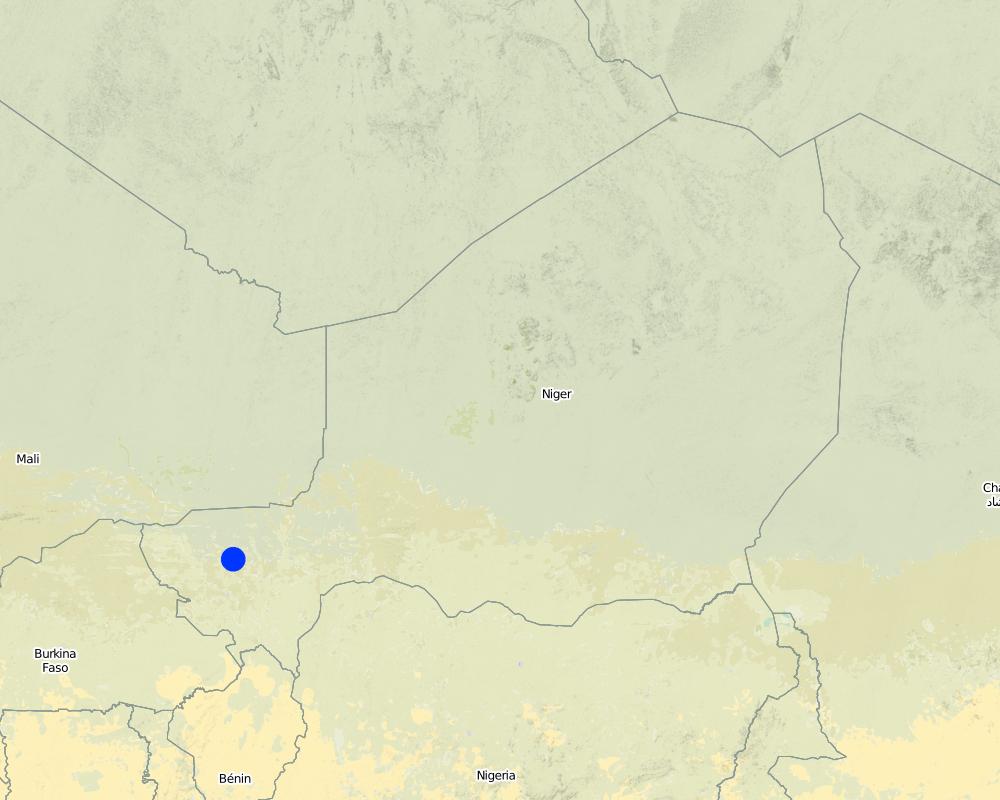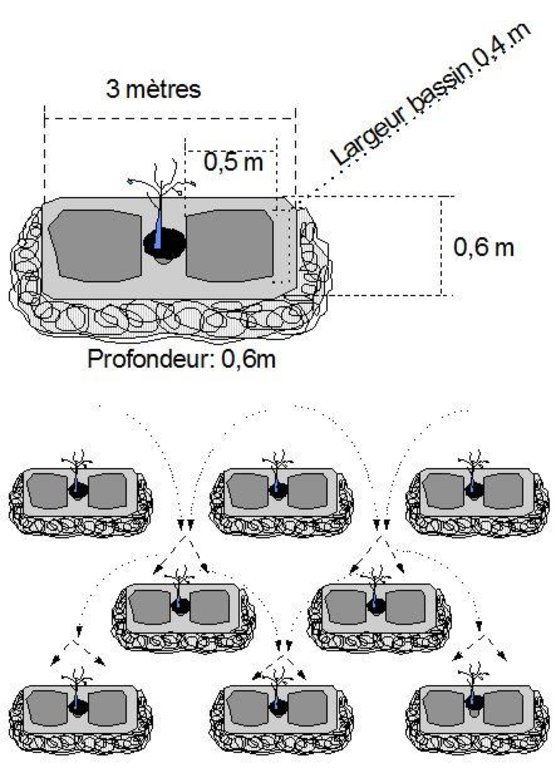Hand-dug trenches [Niger]
- Creation:
- Update:
- Compiler: Dieter Nill
- Editor: –
- Reviewer: David Streiff
Tranchées manuelles (French)
technologies_1625 - Niger
View sections
Expand all Collapse all1. General information
1.2 Contact details of resource persons and institutions involved in the assessment and documentation of the Technology
SLM specialist:
Dorlöchter-Sulser Sabine
Misereor
Germany
SLM specialist:
Mamadou Abdou Gaoh Sani
mamadou.sani@giz.de
Programme d’Appui à l’agriculture Productive (PROMAP)
Niamey
Niger
Name of project which facilitated the documentation/ evaluation of the Technology (if relevant)
Programme d’Appui à l’agriculture Productive (GIZ / PROMAP)Name of the institution(s) which facilitated the documentation/ evaluation of the Technology (if relevant)
Deutsche Gesellschaft für Internationale Zusammenarbeit (GIZ) GmbH (GIZ) - GermanyName of the institution(s) which facilitated the documentation/ evaluation of the Technology (if relevant)
Misereor - Germany1.3 Conditions regarding the use of data documented through WOCAT
When were the data compiled (in the field)?
01/07/2012
The compiler and key resource person(s) accept the conditions regarding the use of data documented through WOCAT:
Yes
2. Description of the SLM Technology
2.1 Short description of the Technology
Definition of the Technology:
Hand-dug trenches contribute to the restoration of tree cover and prevention of water erosion on slopes.
2.2 Detailed description of the Technology
Description:
This technique is designed to restore communal land on slopes and highland pediments. It involves manually excavating trenches 3 to 3.5 m long and 0.6 m deep, spaced 4 m apart in staggered rows. This results in around 625 trenches per hectare. The excavated earth is piled downhill of the trenches, which are aligned perpendicular to the slope. In the middle of each trench, a 0.40 m high step is left on which the tree seedling is planted. The tree receives the water it needs from the trench where it collects.
Purpose of the Technology: The main purpose of this technique is to restore tree cover on degraded, unfertile land and prevent water erosion on slopes by reducing the flow of water that threatens land downstream. The trenches reduce gully erosion and pedimentation of areas with a fragile soil structure. Like all afforestation measures, in the medium term, this technique is effective in protecting the land against water and wind erosion. The shade provided by the trees also lowers the temperature of the soil and the infiltration of water in the hand-dug trenches contributes to groundwater recharge.
Areas restored using hand-dug trenches can subsequently be exploited to a limited extent in accordance with strict controls.
Establishment / maintenance activities and inputs: The technique is very labour intensive. Work must begin immediately after harvesting when the soil is still moist and workable. A protection and monitoring system is required to ensure that grazing animals do not damage the young trees. The mortality of trees after planting is relatively high (survival rate is about 60%), and dead trees must be replaced systematically during the first three years. Good community organisation is required.
Natural / human environment: Hand-dug trenches are particularly useful when rainfall is low, as they retain water and make it available to the trees growing in them. In years when rainfall is abundant or there are violent downpours, the young trees are protected, as they are planted on a raised step within the trench, although there is a risk of flooding in the event of very heavy rain.
2.3 Photos of the Technology
2.5 Country/ region/ locations where the Technology has been applied and which are covered by this assessment
Country:
Niger
Region/ State/ Province:
Niger
Further specification of location:
Regions of Tillabéri, Filingué, Ouallam, Téra and Tahuoa
Map
×2.6 Date of implementation
If precise year is not known, indicate approximate date:
- 10-50 years ago
2.7 Introduction of the Technology
Specify how the Technology was introduced:
- through projects/ external interventions
Comments (type of project, etc.):
Developed, implemented and disseminated as part of projects and programmes undertaken from the 1980s onwards to combat desertification and improve natural resource management. Implemented by German Development Cooperation (BMZ, GIZ, KfW) in Niger by projects e.g. PDRT (Projet de développement rural de Tahoua - Tahoua Rural Development Project)
3. Classification of the SLM Technology
3.1 Main purpose(s) of the Technology
- reduce, prevent, restore land degradation
3.2 Current land use type(s) where the Technology is applied

Cropland
- Annual cropping
- Tree and shrub cropping
Main crops (cash and food crops):
major cash crop: Ground nut
major food crop: Millet
other: Sorghum, cow peas and mangoes

Mixed (crops/ grazing/ trees), incl. agroforestry
- Agro-pastoralism
Comments:
Major land use problems (compiler’s opinion): water erosion (gully, sheet), wind erosion, degraded and infertile land
Nomadism: Yes
Semi-nomadism / pastoralism: Yes
Cut-and-carry/ zero grazing: Yes
Improved pasture: Yes
Mixed: (eg agro-pastoralism, silvo-pastoralism): Yes
Other grazingland: agropastoralism
Selective felling of (semi-) natural forests: Yes
Forest products and services: timber, fuelwood, fruits and nuts, grazing / browsing, other forest products / uses (honey, medical, etc.)
Type of cropping system and major crops comments: armers are mainly agropastoralists with some communities specialised on pure pastoralism
Constraints of common grazing land
Constraints of forested government-owned land or commons
3.3 Further information about land use
Water supply for the land on which the Technology is applied:
- rainfed
Comments:
Water supply: Also mixed rainfed - irrigated and post-flooding
Number of growing seasons per year:
- 1
Specify:
Longest growing period in days: 120; Longest growing period from month to month: August to October
Livestock density (if relevant):
1-10 LU /km2
3.4 SLM group to which the Technology belongs
- improved ground/ vegetation cover
- irrigation management (incl. water supply, drainage)
3.5 Spread of the Technology
Specify the spread of the Technology:
- evenly spread over an area
3.6 SLM measures comprising the Technology

vegetative measures
- V1: Tree and shrub cover

structural measures
- S3: Graded ditches, channels, waterways
3.7 Main types of land degradation addressed by the Technology

soil erosion by water
- Wt: loss of topsoil/ surface erosion
- Wg: gully erosion/ gullying
- Wo: offsite degradation effects

soil erosion by wind
- Et: loss of topsoil

chemical soil deterioration
- Cn: fertility decline and reduced organic matter content (not caused by erosion)

biological degradation
- Bc: reduction of vegetation cover

water degradation
- Ha: aridification
- Hg: change in groundwater/aquifer level
Comments:
Secondary types of degradation addressed: Et: loss of topsoil, Hg: change in groundwater / aquifer level
Main causes of degradation: soil management (Unadapted land use methods, reduced or abandoned fallow periods), crop management (annual, perennial, tree/shrub) (Neglect of fallow periods and crop rotation), droughts (due to heat waves), population pressure (rapidly growing population increasing pressure on land), land tenure (insecure access to land and collectively managed communal land), poverty / wealth (very poor population)
Secondary causes of degradation: deforestation / removal of natural vegetation (incl. forest fires) (deforestation through overgrazing and fire wood collection), over-exploitation of vegetation for domestic use (firewood collection), overgrazing (cattle, sheep and goats), change in temperature (Climate change: heat waves), change of seasonal rainfall (more variable onset of rains), Heavy / extreme rainfall (intensity/amounts) (more variable and intensive rains), wind storms / dust storms (frequent storms), floods (due to intensive rain storms), labour availability (some migration of men to nearby cities), education, access to knowledge and support services (high level of illiteracy)
3.8 Prevention, reduction, or restoration of land degradation
Specify the goal of the Technology with regard to land degradation:
- restore/ rehabilitate severely degraded land
Comments:
Secondary goals: prevention of land degradation, mitigation / reduction of land degradation
4. Technical specifications, implementation activities, inputs, and costs
4.1 Technical drawing of the Technology
4.2 Technical specifications/ explanations of technical drawing
Trenches are manually excavated 3 to 3.5 m long and 0.6 m deep, spaced 4 m apart in staggered rows. This results in around 625 trenches per hectare. The excavated earth is piled downhill of the trenches, which are aligned perpendicular to the slope. In the middle of each trench, a 0.40 m high step is left on which the tree seedling is planted. The tree benefits from the water collected in the trench.
Technical knowledge required for field staff / advisors: moderate
Technical knowledge required for land users: low
Main technical functions: control of dispersed runoff: retain / trap, control of dispersed runoff: impede / retard, control of concentrated runoff: retain / trap, control of concentrated runoff: impede / retard, control of concentrated runoff: drain / divert, improvement of ground cover, stabilisation of soil (eg by tree roots against land slides), increase of infiltration, increase / maintain water stored in soil, water harvesting / increase water supply
Secondary technical functions: increase in organic matter, increase in nutrient availability (supply, recycling,…), increase of groundwater level / recharge of groundwater, sediment retention / trapping, sediment harvesting, reduction in wind speed, increase of biomass (quantity), promotion of vegetation species and varieties (quality, eg palatable fodder)
Vegetative measure: planted in trench
Vegetative material: T : trees / shrubs, G : grass
Vegetative measure: Vegetative material: T : trees / shrubs, G : grass
Retention/infiltration ditch/pit, sediment/sand trap
Spacing between structures (m): 4
Depth of ditches/pits/dams (m): 0.6
Length of ditches/pits/dams (m): 3.5
Vegetation is used for stabilisation of structures.
4.3 General information regarding the calculation of inputs and costs
Specify currency used for cost calculations:
- US Dollars
4.4 Establishment activities
| Activity | Type of measure | Timing | |
|---|---|---|---|
| 1. | marking out the contour line | Structural | |
| 2. | laying out the trenches in staggered rows | Structural | |
| 3. | digging two rectangular microcatchments separated horizontally by a flat surface | Structural | |
| 4. | making a hole in the central area | Vegetative | |
| 5. | planting the seedlings | Vegetative | |
| 6. | sowing grass on the ridges | Vegetative |
4.5 Costs and inputs needed for establishment
| Specify input | Unit | Quantity | Costs per Unit | Total costs per input | % of costs borne by land users | |
|---|---|---|---|---|---|---|
| Labour | All the Labour | unit | 1.0 | 220.76 | 220.76 | |
| Plant material | Seedlings | unit | 1.0 | 41.55 | 41.55 | |
| Other | Transport of seedlings | unit | 1.0 | 1.93 | 1.93 | |
| Total costs for establishment of the Technology | 264.24 | |||||
4.6 Maintenance/ recurrent activities
| Activity | Type of measure | Timing/ frequency | |
|---|---|---|---|
| 1. | A protection and monitoring system is required to ensure that grazing animals do not damage the young trees | Vegetative | |
| 2. | dead trees must be replaced systematically during the first three years | Vegetative |
4.8 Most important factors affecting the costs
Describe the most determinate factors affecting the costs:
Other costs
• equipment, such as jumper bars, shovels and axes
• 625 tree seedlings
• 15 kg of grass seed
• cost of transporting 2 cartloads of seedlings
• 120 seedlings to replace dead trees.
5. Natural and human environment
5.1 Climate
Annual rainfall
- < 250 mm
- 251-500 mm
- 501-750 mm
- 751-1,000 mm
- 1,001-1,500 mm
- 1,501-2,000 mm
- 2,001-3,000 mm
- 3,001-4,000 mm
- > 4,000 mm
Agro-climatic zone
- semi-arid
Thermal climate class: subtropics
5.2 Topography
Slopes on average:
- flat (0-2%)
- gentle (3-5%)
- moderate (6-10%)
- rolling (11-15%)
- hilly (16-30%)
- steep (31-60%)
- very steep (>60%)
Landforms:
- plateau/plains
- ridges
- mountain slopes
- hill slopes
- footslopes
- valley floors
Altitudinal zone:
- 0-100 m a.s.l.
- 101-500 m a.s.l.
- 501-1,000 m a.s.l.
- 1,001-1,500 m a.s.l.
- 1,501-2,000 m a.s.l.
- 2,001-2,500 m a.s.l.
- 2,501-3,000 m a.s.l.
- 3,001-4,000 m a.s.l.
- > 4,000 m a.s.l.
Comments and further specifications on topography:
Altitudinal zone: 200 m a.s.l.
Landforms: Also footslopes and valley floors
5.3 Soils
Soil depth on average:
- very shallow (0-20 cm)
- shallow (21-50 cm)
- moderately deep (51-80 cm)
- deep (81-120 cm)
- very deep (> 120 cm)
Soil texture (topsoil):
- medium (loamy, silty)
- fine/ heavy (clay)
Topsoil organic matter:
- low (<1%)
If available, attach full soil description or specify the available information, e.g. soil type, soil PH/ acidity, Cation Exchange Capacity, nitrogen, salinity etc.
Soil fertility is very low - medium
Soil drainage / infiltration is poor - medium
Soil water storage capacity is low - medium
5.4 Water availability and quality
Ground water table:
5-50 m
Availability of surface water:
medium
Water quality (untreated):
for agricultural use only (irrigation)
Comments and further specifications on water quality and quantity:
Ground water table: > 10m
Availability of surface water: Surface runoff generated by limited but intense rainfalls
5.5 Biodiversity
Species diversity:
- low
5.6 Characteristics of land users applying the Technology
Market orientation of production system:
- subsistence (self-supply)
- mixed (subsistence/ commercial
Off-farm income:
- 10-50% of all income
Relative level of wealth:
- very poor
- poor
Level of mechanization:
- manual work
- animal traction
Gender:
- men
Indicate other relevant characteristics of the land users:
Population density: 10-50 persons/km2
Annual population growth: 3% - 4%
(mostly poor households below poverty line).
Off-farm income specification: men migrate temporarily or permanently to cities for off-farm income, women and men seasonally carry out paid farm work
Market orientation of production system: Most households crop for subsistence , but surplus is sold on the market. Some vegetable growing is just for commercial/ market.
Level of mechanization: Oxes and donkeys used for animal traction.
5.7 Average area of land owned or leased by land users applying the Technology
- < 0.5 ha
- 0.5-1 ha
- 1-2 ha
- 2-5 ha
- 5-15 ha
- 15-50 ha
- 50-100 ha
- 100-500 ha
- 500-1,000 ha
- 1,000-10,000 ha
- > 10,000 ha
Is this considered small-, medium- or large-scale (referring to local context)?
- small-scale
Comments:
Average area of land owned or leased by land users applying the Technology: Also 1-2 ha
5.8 Land ownership, land use rights, and water use rights
Land ownership:
- state
- communal/ village
- not titled
Land use rights:
- individual
Comments:
Traditional land use rights prevail. On fields individual land use rights, communal rights on pasture and forest land (collection of wood and other products (fruits, medicinal plants))
5.9 Access to services and infrastructure
health:
- poor
- moderate
- good
education:
- poor
- moderate
- good
technical assistance:
- poor
- moderate
- good
employment (e.g. off-farm):
- poor
- moderate
- good
markets:
- poor
- moderate
- good
energy:
- poor
- moderate
- good
roads and transport:
- poor
- moderate
- good
drinking water and sanitation:
- poor
- moderate
- good
financial services:
- poor
- moderate
- good
6. Impacts and concluding statements
6.1 On-site impacts the Technology has shown
Socio-economic impacts
Production
fodder production
fodder quality
wood production
production area
Income and costs
workload
Socio-cultural impacts
SLM/ land degradation knowledge
livelihood and human well-being
Comments/ specify:
This technique permits the reintroduction of trees on degraded, unfertile land. Areas restored using hand-dug trenches can subsequently be exploited to a limited extent in accordance with strict controls.
Ecological impacts
Water cycle/ runoff
harvesting/ collection of water
surface runoff
excess water drainage
groundwater table/ aquifer
Soil
soil moisture
soil cover
soil loss
soil crusting/ sealing
nutrient cycling/ recharge
Biodiversity: vegetation, animals
biomass/ above ground C
plant diversity
Climate and disaster risk reduction
wind velocity
6.2 Off-site impacts the Technology has shown
downstream flooding
downstream siltation
wind transported sediments
6.3 Exposure and sensitivity of the Technology to gradual climate change and climate-related extremes/ disasters (as perceived by land users)
Gradual climate change
Gradual climate change
| Season | Type of climatic change/ extreme | How does the Technology cope with it? | |
|---|---|---|---|
| annual temperature | increase | well |
Climate-related extremes (disasters)
Meteorological disasters
| How does the Technology cope with it? | |
|---|---|
| local rainstorm | not well |
| local windstorm | well |
Climatological disasters
| How does the Technology cope with it? | |
|---|---|
| drought | well |
Hydrological disasters
| How does the Technology cope with it? | |
|---|---|
| general (river) flood | not well |
Other climate-related consequences
Other climate-related consequences
| How does the Technology cope with it? | |
|---|---|
| reduced growing period | not known |
Comments:
Damages are generally small but need to be repaired quickly.
6.4 Cost-benefit analysis
How do the benefits compare with the establishment costs (from land users’ perspective)?
Short-term returns:
slightly negative
Long-term returns:
slightly positive
How do the benefits compare with the maintenance/ recurrent costs (from land users' perspective)?
Short-term returns:
slightly negative
Long-term returns:
slightly positive
Comments:
Establishment of the trenches involves considerable labour and growth of trees takes a couple of years.
6.5 Adoption of the Technology
Of all those who have adopted the Technology, how many have did so spontaneously, i.e. without receiving any material incentives/ payments?
- 0-10%
Comments:
Comments on acceptance with external material support: The technology has been applied by PDRT on common land using food/cash for work in order to inject money and food into the local communities.
Comments on spontaneous adoption: There was no spontaneous adoption. The technology is designed for common lands and takes considerable labour that only very well organised communities are able to mobilise.
There is no trend towards spontaneous adoption of the Technology
6.7 Strengths/ advantages/ opportunities of the Technology
| Strengths/ advantages/ opportunities in the land user’s view |
|---|
| The young trees are protected of flooding, as they are planted on a raised step within the trench |
| Strengths/ advantages/ opportunities in the compiler’s or other key resource person’s view |
|---|
| Hand-dug trenches retain water and make it available to the trees growing in them. Although the trenches are progressively filled with sediment, which reduces their capacity to retain water, at the same time, the trees develop and become less dependent on stored water. |
| This technique has proved effective in restoring forest/rangeland sites. The progressive development of grass and tree cover continues on the improved sites, where the tree population is up to 20 years old. After around ten years, the average annual production of wood is 1.3 steres per hectare. |
| The shade provided by the trees also lowers the temperature of the soil. |
|
In the medium term, this technique is effective in protecting the land against water and wind erosion. |
| Areas restored using hand-dug trenches can subsequently be exploited to a limited extent in accordance with strict controls. |
6.8 Weaknesses/ disadvantages/ risks of the Technology and ways of overcoming them
| Weaknesses/ disadvantages/ risks in the compiler’s or other key resource person’s view | How can they be overcome? |
|---|---|
| The technique is very labour intensive. Work must begin immediately after harvesting when the soil is still moist and workable. | Good community organisation is required. |
| A protection and monitoring system is required to ensure that grazing animals do not damage the young trees. The mortality of trees after planting is relatively high (survival rate is about 60%), and dead trees must be replaced systematically during the first three years. |
7. References and links
7.3 Links to relevant information which is available online
Title/ description:
Good Practices in Soil and Water Conservation. A contribution to adaptation and farmers´ resilience towards climate change in the Sahel. Published by GIZ in 2012.
URL:
http://agriwaterpedia.info/wiki/Main_Page
Links and modules
Expand all Collapse allLinks
No links
Modules
No modules


